Crazy plan to 'capture' the rocket to return to Earth by helicopter
It is known that they will use a giant helicopter with a special structure, which can "catch" the rocket before it makes contact with the Earth's surface. If this daring plan is successful, it will be the world's first reusable small spacecraft launch vehicle.

The Electron rocket is launched Rocket Lab.
The test, scheduled for April 19, is at Launch Complex 1 of the Māhia Peninsula, New Zealand. This is part of the "There and Back Again" mission, with the main rocket used being the Electron-26 built by Rocket Lab, carrying 34 payloads (most of them). are satellites) from a variety of commercial operators to Earth orbit.
After the rocket brings the satellites into range, it will return to Earth. However, instead of landing in the ocean (and never being used again) like other times, Rocket Lab will try to "catch" the rocket before it hits the surface of our planet, and will be reuse for future flights.
However, according to the researchers, the whole process is not simple. Capturing a rocket in mid-air as it comes back from space is an incredibly complex operation that requires extreme precision, with a near-zero margin of error.
Rocket Lab founder and CEO Peter Beck said the company has repeatedly used helicopters to carry out similar tests, and successfully recovered rockets from the ocean. He said they were ready for this bold plan.
The successful mission is expected to bring the total number of satellites launched into orbit by Electron to 146, and is the next major milestone in making Electron a reusable rocket.
Unlike SpaceX, whose Falcon 9 rocket can land safely on an unmanned "aircraft carrier", Rocket Lab is showing itself bolder in its efforts to recover rockets aimed at reuse purposes.
- America intends to use a helicopter to
- NASA tossed a fake video of
- Russia tests unmanned aerial cum-shot helicopter
- Proposing to cover the Sun to cope with global warming
- Video: How to make a helicopter so simple
- China intends to capture asteroids that pull down to Earth
- NASA wants to 'capture' meteorites as a space station
- Follow the rocket to outer space and return to Earth
- China's Changping 5B rocket falls to Earth uncontrollably
- Some information about Elon Musk's Mars settlement plan
- Helicopters run by human power
- The first photograph captures Earth from a rocket 70 years ago
 Van Allen's belt and evidence that the Apollo 11 mission to the Moon was myth
Van Allen's belt and evidence that the Apollo 11 mission to the Moon was myth The levels of civilization in the universe (Kardashev scale)
The levels of civilization in the universe (Kardashev scale) Today Mars, the sun and the Earth are aligned
Today Mars, the sun and the Earth are aligned The Amazon owner announced a secret plan to build a space base for thousands of people
The Amazon owner announced a secret plan to build a space base for thousands of people